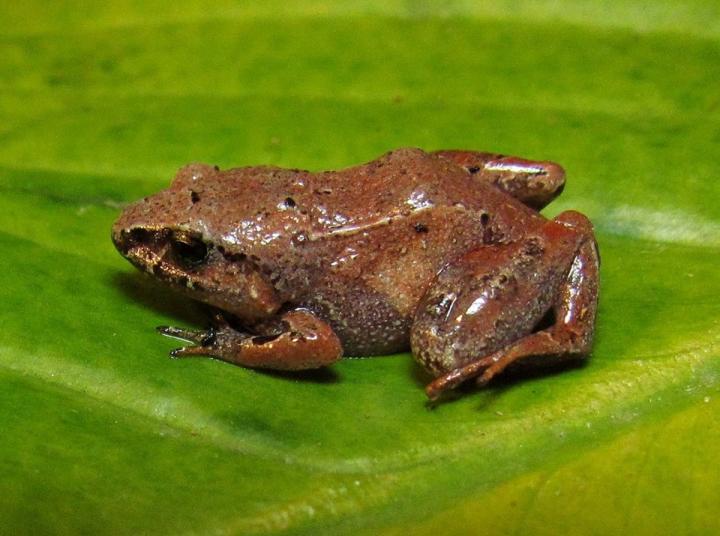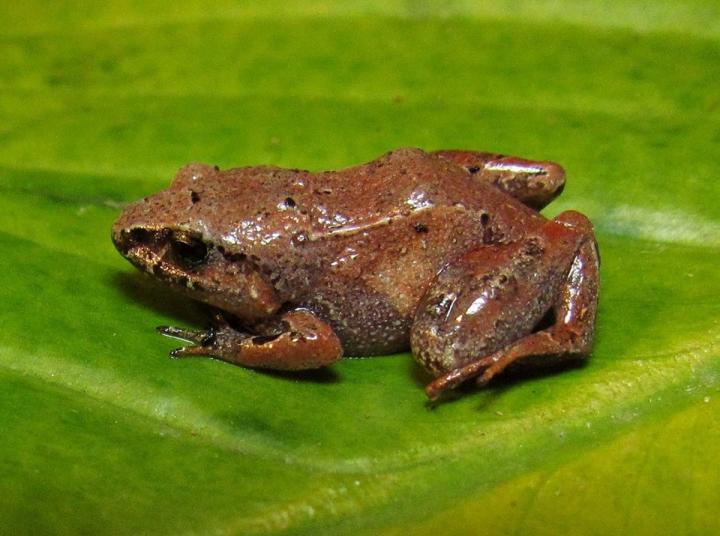
Credit: Fábio Maffei
Global warming could lead to the extinction of up to 10% of frog and toad species endemic to Brazil's Atlantic Rainforest biome within about the next 50 years. The temperature and precipitation regimes predicted to occur between 2050 and 2070 will be lethal for species that are less well adapted to climate variation and inhabit certain areas of the Atlantic Rainforest.
This is one of the findings of a study that analyzes the present and future distribution of anurans (tailless amphibians, i.e., frogs and toads) in Brazil's Atlantic Rainforest and Cerrado (savanna) biomes in the context of climate change due to continuous global warming.
A paper on the study has been published in the journal Ecology and Evolution. The first author is herpetologist Tiago da Silveira Vasconcelos, a researcher at São Paulo State University's School of Sciences (FC-UNESP) in Bauru, Brazil.
At present, 550 anuran species are known to inhabit the Atlantic Rainforest (80% of them endemic), and 209 are known to be present in the Cerrado. After removing species with fewer than five occurrence records, Vasconcelos worked with spatial distribution data for 350 species in the Atlantic Rainforest and 155 species in the Cerrado.
"In this manner, we were able to identify the Atlantic Rainforest and Cerrado areas with the highest levels of anuran species richness and with unique species composition," Vasconcelos said. "Having identified these areas, we evaluated the anuran communities in current and future climate scenarios in order to determine which areas offered a favorable climate for each of the 505 species analyzed and whether the areas would expand or contract by 2050 and 2070 owing to global warming."
The investigator had the support of the São Paulo Research Foundation – FAPESP through its Research Program on Global Climate Change .
"The first expected impact of climate change on anuran amphibians in the Atlantic Rainforest and Cerrado is the extinction of 42 species due to the complete loss of the areas with favorable climate conditions between 2050 and 2070," Vasconcelos said.
From the 42 species likely to be extinct, 37 of them are Atlantic Rainforest species (10.6% of the total) and five are Cerrado species. Of these 42 species, only five are currently considered endangered by Brazil's Environment Ministry.
Methodology
The spatial distribution data for 350 Atlantic Rainforest species and 155 Cerrado species were analyzed in terms of two community ecology metrics: alpha diversity, defined as local species richness within a specific habitat or ecosystem, and beta diversity, a measure of structural heterogeneity based on the extent to which species composition varies as a function of distance.
According to Vasconcelos, the next step was to generate ecological niche models based on the climate characteristics favorable to each species, using four algorithms: generalized linear models, boosted regression trees, random forests, and support vector machines.
The algorithms generated maps of the Atlantic Rainforest and Cerrado areas in which each species can survive thanks to their similar climates. They were then calibrated with future climate scenarios based on projections available from the WorldClim global climate database.
"In projecting future climate change conditions for 2050 and 2070, we used two carbon gas emission scenarios – one more optimistic with less global warming and the other more pessimistic and warmer. We also used three different atmosphere-ocean global circulation models," explained the FAPESP-supported researcher. The scenarios and models are from the Fifth Assessment Report of the Intergovernmental Panel on Climate Change (IPCC).
"For each of the 505 species analyzed, we generated 24 distribution maps [four algorithms x two carbon emission scenarios x three global circulation models]. That's 12,000 maps all told," he said.
The 24 distribution maps for each species were then used to generate a consensus map and a species presence-absence matrix to determine the forecast occurrence of each species in 2050 and 2070.
Homogenization of amphibians in the Cerrado
The highest levels of anuran species richness in the Atlantic Rainforest are currently found in the southeastern part of the biome, in Espírito Santo, Paraná, Rio de Janeiro, Santa Catarina and São Paulo State. Inland areas have lower levels of anuran species richness.
Although the results of the FAPESP-funded study point to species loss throughout the biome, even the higher rates of loss in its southeastern portion will not prevent this specific region from remaining the richest in anuran amphibians.
On the other hand, there will be species loss throughout the Cerrado but also biodiversity gains in some regions.
"The results of our research show expansion of the areas with favorable climate conditions for anuran amphibians. Rising temperatures will lead to the expansion of Cerrado areas in a northern and northwestern direction, occupying what is now Amazon forest," Vasconcelos said. "The savannization of Amazon forest areas will open up new areas for occupation by amphibians from the Cerrado."
In the Cerrado, climate change will not affect the area with the highest level of anuran species richness, which is on the southern edge of the biome, but a considerable loss of species is predicted in the western and southwestern portions of the biome adjacent to the low-lying Pantanal wetlands. On the other hand, species richness may increase in Tocantins, northern Minas Gerais and western Bahia.
"The future climate change scenarios suggest there may be homogenization of anuran species throughout the Cerrado. In other words, the areas occupied by more generalist species that have adapted to different habitats and can tolerate wider temperature and humidity variations are expected to expand," Vasconcelos said.
###
About São Paulo Research Foundation (FAPESP)
The São Paulo Research Foundation (FAPESP) is a public institution with the mission of supporting scientific research in all fields of knowledge by awarding scholarships, fellowships and grants to investigators linked with higher education and research institutions in the State of São Paulo, Brazil. FAPESP is aware that the very best research can only be done by working with the best researchers internationally. Therefore, it has established partnerships with funding agencies, higher education, private companies, and research organizations in other countries known for the quality of their research and has been encouraging scientists funded by its grants to further develop their international collaboration. For more information: http://www.fapesp.br/en.
Media Contact
Joao Carlos da Silva
[email protected]
55-113-838-4381
@AgencyFAPESP
http://www.fapesp.br
Original Source
http://agencia.fapesp.br/28689 http://dx.doi.org/10.1002/ece3.4357





